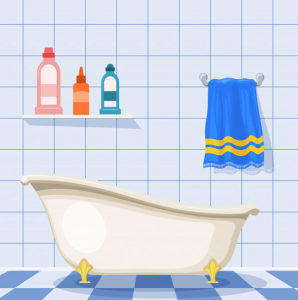
Bath time can be a fun activity for both parents and their children to enjoy, but a drowning incident can occur in the blink of an eye and parents should be wary of this possibility. With an average of 87 children under 5 drowning each year and 80% of these deaths occurring in bathtubs, bathroom safety should be a priority of parents with young children. Just as you would in any large bodies of water, supervising your child at all times is key to being able to respond quickly. Children can drown in just a few inches of water so it is not worth it to leave to take a phone call or go to another room with the bathroom door left open. Dedicate your time to your child as a measure of ensuring their safety. For parents with multiple children, it is also not advisable to leave younger babies and toddlers under the supervision of another young child. Young children may not be able to identify safety risks as readily as a parent. While a parent is in the bathroom with the toddler/child it would be wise to remain within arm’s length of them at all times so that one may be ready in the event that a child’s head gets submerged under water. Another great protection against drownings in the bathroom is having at least one parent learn CPR, a procedure that could potentially save your child’s life.
While drowning in the bathtub is a significant risk to be aware of in the bathroom, a plethora of other preventable injuries may occur in the bathroom that parents should be aware of. Around 43 thousand children are injured each year by slip and fall accidents in the bathroom. For toddlers there are products that secure them in place whilst using the bathtub so that they will not fall over and parents can be more hands free. For slightly older children, slip mats in the bathtub can give them something for their feet to stick to. Products such as these are inexpensive when compared to your child’s safety. Another common injury has to do with babies and water temperature. Babies have thinner skin than adults and therefore are more susceptible to scalding. Be wary of the temperature your water is at before placing your child under it. Finally, it important not to leave unattended bodies of water in your bathroom no matter how shallow it may be. Toddlers wander around and can easily fall into objects such as buckets and potentially drown. Taking these different risks into account will prepare any parent for a fun and safe bathroom experience with their child.
David Wolf is a personal injury attorney and child safety advocate. He is the author of 12 books that focus on personal injury and child safety matters.
